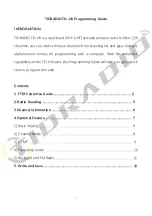
FR146
•
19
Further alignment now consists of adjusting the oscillator coil L3 to permit the
tuning control (R1) to cover the 5 MHz. segment between 135 and 175 MHz of
primary interest to you. Assuming you wish to adjust for the Two Meter 144-148
MHz Amateur Band, adjust L3 until you hear your intended test signal.
If you are a beginner with no license or other equipment, any Ham operator with
a 2-meter transceiver should be willing to give you the test signal and extra help
that you need. The FR146 is very sensitive, so operate the transceiver on low
power on a simplex frequency from a distance of at least across the room. An 8"
piece of wire will be a sufficient receiving antenna for such tests. If you don't
know any Hams, visit a friendly two-way radio service center to get close to the
test signal you need!
RECEIVER SENSITIVITY
Your FM receiver features sensitivity under 1 uv. Radio Hams constantly marvel
at how an FR146 displayed at hamfests tunes in dozens of hand-held QSO's on
the premises without an antenna connected! You can expect to monitor local
repeater and simplex transmissions easily, using a simple groundplane style
antenna. The receiver also responds very well to the addition of a low-noise pre-
amplifier such as the Ramsey SA-7/PR-2. For 2 meters, the Ramsey PR-10,
with its high-Q tuned circuitry and exceptional signal-to-noise ratio, offers
significant performance improvement. A new and versatile receiver accessory is
the Ramsey AA-7 HF-VHF Active Antenna, which doubles as a preamplifier with
other antennas in addition to the excellent performance of its own whip.
ADDING AN LED POWER "ON" INDICATOR
For many people, a pilot lamp to indicate "power on" is more than a nice touch.
They expect it and depend on it, reminding us that "real radios glow in the dark!"
Adding a simple LED power-on indicator to your Ramsey kit receiver is easy. All
you need is the LED itself and a small 1K to 2.2K resistor.
Study the PC traces between the positive battery supply wire and the on-off
switch. The unused connectors on top of your switch are an ideal point to get the
+ DC voltage needed for the anode (longer lead) of the LED. Plan where and
how you wish to install the LED in your enclosure.
Содержание FR146
Страница 8: ...FR146 8 U2 3359 FR146 BLOCK DIAGRAM U1 SA602 MIXER...
Страница 9: ...FR146 9 FR146 PARTS LAYOUT DIAGRAM...
Страница 12: ...FR146 12...
Страница 13: ...FR146 13...






































